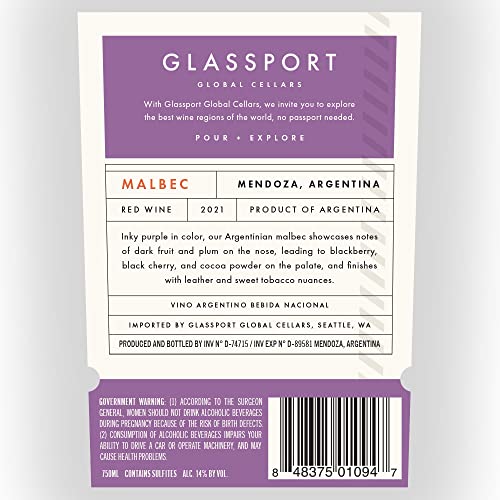Best Malbec Wines: Top Picks & Expert Guide
Post Disclaimer
*We may earn a commission for purchases made using our links. Please see our disclosure to learn more.
The moment I first tasted a proper Malbec from Mendoza’s high-altitude vineyards, I knew I’d found something special. That deep purple color, those rich blackberry notes, the velvety texture, it was a revelation that began my love affair with this remarkable varietal. Over the years, I’ve explored everything from budget-friendly bottles to premium single-vineyard expressions, and I’m excited to share what I’ve learned about selecting the best Malbec wines available today.
Whether you’re a curious newcomer or a seasoned enthusiast looking to expand your Malbec horizons, this guide will walk you through what makes these wines so captivating and which bottles deserve a place in your collection.
Key Takeaways
- Origin Matters: While Malbec originated in France, Argentinian Malbecs (particularly from Mendoza) have become the standard-bearers for this varietal.
- Flavor Profile: Look for rich black fruits, plum, and blackberry flavors with additional notes of cocoa, tobacco, leather, and sometimes violet.
- Food Pairing: Malbec pairs excellently with grilled red meats, especially beef, as well as heartier dishes with mushrooms or blue cheese.
- Aging Potential: Quality Malbecs can age beautifully for 5-10 years, developing more complex flavors over time.
- Value: Malbec often offers excellent quality-to-price ratio compared to other red wines, with outstanding bottles available at various price points.
Top Malbec Wine Recommendations
1. Catena Malbec
Experience the bold elegance of Catena Malbec, a premium red wine from Mendoza, Argentina. This award-winning 2018 vintage showcases a deep violet hue with rich aromas of ripe red and dark fruits, complemented by delicate violet, lavender, vanilla, and mocha notes. Crafted from high-altitude vineyards, it offers a smooth texture and concentrated flavors, making it a perfect choice for any wine enthusiast. Enjoy it with grilled steak, roast turkey, salmon, or pasta with red sauce for an unforgettable pairing.
- Flavor Profile: Rich, full-bodied flavor with smooth tannins
- Quality: Award-winning vintage with high ratings
- Food Pairing: Versatile pairing with meats and pasta
- Vintage Variation: Vintage may vary
- Price: Higher price point compared to other Malbecs
- Boldness: Bold flavors may not suit all palates
Price Range: $17.99-$19.99
Hailing from Argentina’s renowned Mendoza region, Catena Malbec is a testament to the elegance and depth this varietal can achieve. From the moment you pour a glass, its deep violet hue and captivating aromas of ripe red and dark fruits, violets, and mocha invite you in. On the palate, layers of blackberry, plum, and vanilla unfold with a smooth, well-balanced texture and refined tannins. Aged in oak for added complexity, this award-winning Malbec is perfect for pairing with grilled steak, roasted turkey, or rich pasta dishes. A remarkable value for those seeking a premium yet accessible red wine experience.
2. Alamos Malbec
From the heart of Argentina’s Mendoza region, Alamos Malbec is a smooth and fruit-forward red wine that delivers excellent quality at an affordable price. This medium-bodied Malbec features rich flavors of plum, dark cherry, and blackberry, balanced by soft tannins and a velvety finish. Awarded 91 points by James Suckling, it offers a well-rounded taste that pairs beautifully with red meats, poultry, and hearty pasta dishes. Whether for a casual evening or a special gathering, this Malbec is a go-to choice for wine lovers seeking both flavor and value.
- Flavor Profile: Rich fruit flavors with plum, cherry, and blackberry notes
- Drinkability: Smooth tannins and a medium body for easy sipping
- Value: High-quality Malbec at an affordable price
- Vintage Variation: Year may vary, affecting consistency
- Complexity: Less depth compared to higher-end Malbecs
- Sweetness: Fruit-forward profile may be too sweet for some palates
Price Range: $10-15
For an affordable yet flavorful Malbec, Alamos is a top choice. Sourced from Mendoza’s high-altitude vineyards, this fruit-forward red offers vibrant plum, dark cherry, and blackberry flavors with subtle floral and vanilla notes. Its medium body and smooth tannins make it incredibly easy to drink, whether enjoyed on its own or paired with grilled meats, poultry, or pasta. Consistently well-rated and budget-friendly, Alamos Malbec is a fantastic introduction to Argentinian wines—delivering quality and character at an unbeatable price.
3. Trivento Malbec Reserve
Crafted in Mendoza, Argentina, Trivento Malbec Reserve delivers a bold and well-structured expression of this classic varietal. Hand-harvested and aged in French oak for six months, it boasts a deep red-violet color with aromas of ripe red fruits, strawberries, and cherries, accented by subtle hints of coffee and chocolate. On the palate, it offers a full body, fleshy tannins, and a long, lingering finish. Ideal for pairing with grilled meats, hearty stews, and barbecued dishes, this Malbec provides exceptional quality at a great value.
- Flavor Profile: Rich red fruit flavors with hints of coffee and chocolate
- Aging Process: Aged in French oak for added depth and complexity
- Food Pairing: Pairs well with grilled meats and bold dishes
- Vintage Variation: Year may vary, affecting consistency
- Tannin Strength: Fleshy tannins may be too bold for some palates
- Oak Influence: The oak aging may not appeal to those who prefer fruitier wines
Price Range: $10-15
Trivento has built a reputation for high-quality, affordable wines, and their Malbec Reserve is a standout in this price range. I first tried this bottle at a barbecue, and its bold fruit flavors and smooth oak finish made it the perfect match for grilled meats. With ripe strawberries, cherries, and hints of coffee and chocolate, this Malbec strikes a great balance between richness and drinkability. Aged in French oak for six months, it has a full body, fleshy tannins, and a lingering finish, making it an ideal choice for those who appreciate depth and structure without overspending.
4. Glassport Malbec
Crafted in Mendoza, Argentina, Glassport Malbec delivers a rich and approachable expression of this beloved varietal. It opens with aromas of dark fruit and plum, leading to layers of blackberry, black cherry, and cocoa powder on the palate. The finish is smooth, with hints of leather and sweet tobacco, adding depth and complexity. At an exceptionally affordable price, this Malbec is a great everyday choice for those who appreciate bold flavors without the premium cost. Pair it with roasted lamb, mushroom-stuffed peppers, or roasted potatoes for an elevated dining experience.
- Flavor Profile: Dark fruit, cocoa, and subtle tobacco for added depth
- Versatility: Pairs well with a variety of roasted and savory dishes
- Value: Offers impressive complexity at a budget-friendly price
- Vintage Variation: Year may change, leading to slight flavor differences
- Tannin Strength: May be too bold for those who prefer lighter reds
- Oak Influence: Some may find the leather and tobacco notes too pronounced
Price Range: $6-10
Glassport Malbec is an exceptional budget-friendly find that still delivers on bold flavors and smooth complexity. Hailing from Mendoza, Argentina, this Malbec opens with dark fruit and plum aromas, leading to a rich palate of blackberry, black cherry, and cocoa powder. Subtle hints of leather and sweet tobacco add depth, making it taste far more luxurious than its price suggests. With its silky tannins and balanced finish, this wine is perfect for casual dinners or pairing with roasted lamb, mushroom-stuffed peppers, and hearty potatoes. If you’re looking for a go-to Malbec at an unbeatable price, this is it.
Understanding Malbec: A Journey from France to World Renown
When I first began exploring wine seriously, I was surprised to learn that Malbec, now virtually synonymous with Argentina, actually originated in France. Once a significant component in Bordeaux blends and still grown in Cahors (where it’s known as “Côt”), Malbec found its true home in the high-altitude vineyards of Argentina’s Mendoza region in the late 19th century.
The phylloxera epidemic that devastated European vineyards nearly wiped out Malbec in its homeland, but the cuttings brought to Argentina thrived in the Andean foothills. The combination of intense sunlight, cool nights, and poor, well-drained soils created perfect conditions for Malbec to express itself more fully than it ever had in France.
What Makes Argentinian Malbec Special
Having visited both French and Argentinian Malbec vineyards, I can attest to the dramatic differences in expression between these regions. The high-altitude vineyards of Mendoza (often planted at 3,000-5,000 feet above sea level) create unique growing conditions that give Argentinian Malbec its distinctive character:
- Intense sunlight: This leads to thicker grape skins, which contribute deeper color and more robust tannins.
- Dramatic temperature shifts: The cool nights (due to altitude) help preserve acidity and freshness.
- Minimal rainfall: Controlled irrigation from Andean snowmelt allows for precise management of water stress, concentrating flavors in the grapes.
The result is a wine that manages to be simultaneously bold and elegant, powerful enough to stand up to a hearty steak dinner yet complex enough to be enjoyed on its own.
Flavor Profile: What to Expect
A quality Malbec typically boasts a deep purple color that’s almost opaque. On the nose, expect rich aromas of ripe black fruits, particularly blackberry, plum, and black cherry. These are often complemented by floral notes (especially violet), spices, and sometimes hints of cocoa, tobacco, or leather.
The palate typically follows through with those same fruit flavors, carried on a medium to full-bodied structure with moderate acidity and soft, accessible tannins. Oak aging, common for quality Malbecs, adds additional complexity with notes of vanilla, cedar, or toast.
I’ve found that Malbec offers a remarkable sweet spot in the red wine world, bold enough to satisfy lovers of bigger reds like Cabernet Sauvignon, yet approachable enough for those who might find those wines too aggressive or tannic.
Food Pairing: Malbec’s Versatility
While Malbec has earned its reputation as the perfect partner for beef, particularly grilled steaks, its pairing potential extends much further. Over years of experimentation, I’ve found these pairings especially rewarding:
- Classic pairings: Grilled steaks, lamb chops, venison, and other red meats
- Beyond beef: Duck breast, pork tenderloin, mushroom dishes (especially portobello)
- Cheese: Blue cheeses, aged cheddar, gouda
- Vegetarian options: Eggplant parmesan, mushroom risotto, bean-based dishes with rich umami flavors
- Unexpected delights: Dark chocolate desserts (with a fuller-bodied Malbec) or even Mexican mole sauces
The wine’s fruit-forward nature, moderate tannins, and balanced acidity make it remarkably food-friendly across a range of cuisines.
Regions to Know: Beyond Mendoza
While Mendoza remains the undisputed heartland of quality Malbec, producing about 85% of Argentina’s total, I’ve found exciting expressions from other regions worth seeking out:
Salta and the Calchaquí Valley
The world’s highest vineyards (some above 9,800 feet) produce intensely concentrated, aromatic Malbecs with remarkable freshness and minerality. The first time I tasted a Malbec from Salta’s Calchaquí Valley, I was astonished by its floral intensity and distinct saline quality, a completely different expression than the fruit-forward wines of Mendoza.
Patagonia
At the opposite extreme, the cooler climate of Patagonia’s Rio Negro Valley yields more restrained, elegant Malbecs with bright acidity and often pronounced red fruit character alongside the typical black fruit notes. These wines can show surprising complexity and aging potential.
Valle de Uco
Technically part of Mendoza but distinct enough to merit special attention, the high-altitude Valle de Uco (especially Gualtallary and Tupungato) produces some of Argentina’s most prestigious Malbecs. These wines often combine power with remarkable freshness and minerality, a combination I find irresistible.
Value Proposition: Why Malbec Offers Exceptional Bang for Buck
One aspect of Malbec I’ve always appreciated is its remarkable value across all price points. Having led numerous wine tastings over the years, I’ve consistently found that Malbec outperforms many other varietals at equivalent price points:
- Entry-level ($8-15): Even at this price range, you can find balanced, flavorful Malbecs that deliver authentic varietal character—something that’s much harder to find with bargain Cabernet Sauvignon or Pinot Noir.
- Mid-range ($15-30): This sweet spot offers remarkable quality, with wines showing genuine complexity, regional character, and aging potential.
- Premium ($30-60): Stepping up to this range brings significant gains in concentration, complexity, and cellar-worthiness, often rivaling wines that cost twice as much.
- Ultra-premium ($60+): The finest Malbecs can compete with the world’s great wines while still typically costing less than equivalent-quality Bordeaux or Napa Cabernets.
This value proposition makes Malbec an ideal choice for building a wine collection without requiring a second mortgage.
How to Serve and Store Your Malbec
To get the most from your Malbec investment, proper serving and storage are essential:
Serving Temperature
I’ve found that serving Malbec slightly below room temperature, around 60-65°F (15-18°C), allows its aromatics to shine while keeping the alcohol in check. This usually means taking it out of the refrigerator about 45 minutes before serving if it’s been chilled, or giving it 15-20 minutes in the refrigerator if it’s been stored at room temperature.
Decanting
While entry-level Malbecs are typically ready to drink upon opening, I’ve found that almost all Malbecs benefit from at least a brief decant. Even just 15-30 minutes of air contact can dramatically improve the drinking experience. For more premium or youthful examples, 1-2 hours of decanting can work wonders.
Glassware
A standard Bordeaux-style glass with a broader bowl works beautifully for Malbec, allowing adequate space for the aromas to collect while directing the wine to the center of the palate.
Storage
If you’re looking to age your premium Malbecs (and the better examples can evolve beautifully for 5-10 years or more), the usual wine storage guidelines apply: consistent cool temperature (55°F/13°C is ideal), humidity around 70%, darkness, and minimal vibration.
Conclusion: Embracing Malbec’s Bold Charm
My journey with Malbec has been one of continuous discovery and appreciation. From my first taste of an inexpensive bottle that outperformed its price tag to exploring premium single-vineyard expressions that can stand with the world’s finest wines, Malbec has consistently impressed me with its combination of accessibility and depth. If you’re searching for the best Malbec wine, you’ll find a range of options, from bold and fruit-forward styles to more structured, age-worthy selections.
What I find most compelling about Malbec is its honesty. It doesn’t hide behind excessive oak or manipulation, instead offering a pure expression of fruit, terroir, and careful winemaking. Whether you’re new to red wine or a seasoned oenophile, Malbec offers something to appreciate.
The next time you’re planning a dinner party, considering a gift, or simply looking to try something new, I encourage you to explore the world of Malbec. Start with one of my recommended bottles, pair it with something delicious, and enjoy discovering what has made this once-obscure grape variety an international sensation.
Frequently Asked Questions
1. Is Malbec always from Argentina?
No, though Argentina has become synonymous with quality Malbec, the grape actually originated in France, where it’s still grown today, particularly in the Cahors region (where it’s called “Côt”). You can also find interesting Malbec productions from Chile, the United States (particularly Washington State), Australia, and South Africa. Each region brings its own character to the grape, and if you’re looking for the best Malbec wine, exploring these diverse expressions can be a rewarding journey. Still, Argentine examples remain the benchmark for most wine lovers.
2. How long can I keep an opened bottle of Malbec?
In my experience, most Malbecs will maintain their quality for 2-3 days after opening if properly resealed and stored in the refrigerator. More tannic, structured examples might even improve on the second day as they open up with oxygen exposure. I recommend using a vacuum wine preserver for best results, though simply recorking the bottle and refrigerating it will work for short-term storage.
3. Are all Malbecs bold and full-bodied?
While Malbec is generally categorized as a medium to full-bodied red wine, there’s actually significant variation depending on region, producer style, and vintage conditions. Cooler climate Malbecs (like those from Patagonia or higher altitude vineyards) can be quite elegant and medium-bodied, while warmer regions produce more robust examples. Even within Mendoza, you’ll find everything from approachable, juicy styles to powerful, structured wines built for aging.
4. What makes a Malbec “Reserve” or “Gran Reserva”?
Unlike some European wine regions, Argentina doesn’t have strict legal definitions for terms like “Reserva” or “Gran Reserva.” Generally, these designations indicate the producer’s premium offerings, typically made from better vineyard sites, with stricter grape selection, and extended oak aging. I’ve found that Reserve Malbecs usually offer more concentration and complexity than the producer’s standard bottling, though the exact meaning varies by winery. When in doubt, ask your wine merchant about the specific producer’s approach.
5. Can Malbec age well?
Absolutely! While many affordable Malbecs are designed for early consumption, quality examples from good producers and vintages can evolve beautifully for 5-15 years or even longer. As they age, Malbecs typically develop more secondary and tertiary flavors like leather, tobacco, dried fruits, and earthy notes while the primary fruit becomes less dominant. The tannins also soften over time, creating a more integrated, complex drinking experience. If you’re interested in aging Malbec, look for bottles with good structure, balanced acidity, and restrained oak treatment from reputable producers and strong vintages.















